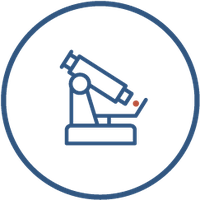Published: 20 November 2025
At BioAscent, we are committed to providing learning opportunities to support the continuous professional development of our staff. As demand for our biosciences services continues to grow, we have welcomed several recent graduates to the BioAscent team. These new scientists are gaining hands-on experience across our wide range of service offerings, including our increasingly popular surface plasmon resonance (SPR) platform. In this blog, Associate Scientist Alexandra Curran reflects on her experience learning to use our Biacore SPR systems.
What was your background prior to joining BioAscent?
I studied for an undergraduate degree in immunology, followed by a Masters in precision medicine at the University of Glasgow, and joined BioAscent after graduating last year. I think I was about half-way through my undergraduate degree when I decided that I wanted to work in the pharma industry and thought that I would enjoy working in an R&D role. I enjoy the fact that I have a people-facing role, interacting with clients, and the mix of hands-on lab work and desk-based analysis in my role at BioAscent.
Did you have any experience of SPR before you came to BioAscent? What was your motivation for learning the technique?
I had no practical experience of SPR before joining BioAscent, though I had learned a lot about the theory behind this technique. SPR is a versatile tool and has many applications in drug discovery, which is one of the reasons that motivated me to learn how to carry out these experiments. SPR can be used to measure a wide range of molecular interactions in real time, including protein-protein interactions and protein-ligand binding events. This technique is disease agnostic, which means that it can be applied across a range of diseases, including oncology, autoimmune and neurodegenerative diseases.
I wanted to take advantage of having access to Biacore systems at BioAscent as they are highly specialised, precision devices that are not that commonly available, especially in academia or small biotech companies.
Did you have mentors who guided you through learning SPR? How did they support you?
Cheryl and Dominika, who are both Senior Scientists in our biosciences team with many years of SPR and protein biochemistry experience, were great mentors. Cheryl taught me the basics of how to run experiments, create methods and analyse data, and I currently work alongside Dominika on a client project, where we collaborate daily on experiments and analyses. I felt very supported as they were both happy to run through experiments with me until I felt comfortable carrying them out independently. They also suggested tools and resources such as certified courses provided by Cytiva to aid in my learning.
What sort of molecules and projects have you been working on using SPR?
I’ve been running SPR experiments with small molecules, including covalent inhibitors, bifunctional degraders and molecular glues. I have been involved in an oncology-focused client project, and I've presented my data during client meetings, which continues to be a valuable learning experience
The team at BioAscent also uses SPR to test biologics, including antibodies. This is something that I might be involved with in the future as my experience with SPR grows and it’s very interesting to see how assay development expertise is really important when adapting assays to differing modalities and molecular properties.
In your experience, how does SPR complement other biophysical techniques at BioAscent?
SPR is a very useful technique as it provides real-time kinetic data that can be used to measure the affinity of an interaction. It’s also a label-free technique and can be used with relatively small amounts of protein compared to some other biophysical techniques.
At BioAscent, we also run thermal shift assays as a complimentary biophysical technique. Once an interaction is confirmed using SPR or thermal shift, we can carry out X-ray crystallography and NMR experiments to provide structural information about the interaction. This information can be used by the medicinal chemistry team at BioAscent to support design and structure activity relationship studies.
What is your favourite thing about SPR as a technique?
I enjoy the fact that SPR experiments are ‘trackable’; I can watch molecules interacting in real time. These SPR sensorgrams are very informative and it’s interesting to be able to efficiently identify issues such as sticky proteins or mismatches in buffer components and then make rapid improvements with additional experiments. I also appreciate how user-friendly the software is, making it straightforward to plan and systemise my experiments.
For me, the most interesting part of learning SPR at BioAscent has been the application to client projects: generating real-world data for our client’s projects and contributing to the bigger picture of discovering new therapies for patients.
BioAscent has the SPR capacity and expertise to support customer research programmes through all stages of the drug discovery process from early hit identification, hit optimisation through to lead candidate. You can learn more about SPR at BioAscent here.




